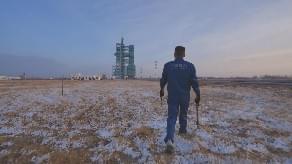Measures taken to guarantee Shenzhou-15 launch at ultra-low temperature.


If you enjoyed this video, you might like my book: https://ageless.link/
I saw a Twitter thread about Bryan Johnson’s ‘Blueprint’, claiming that he’d made himself biologically younger with a highly optimised combination of diet, supplements and exercise. What could that mean? And should we all start chugging 25 pills a day to start on the Blueprint ourselves? Probably not…but the biology behind it is surprisingly interesting.
*Chapters*
00:00 A tweet goes viral.
00:44 Getting ‘biologically younger’
01:23 NAD levels.
03:09 Maximum heart rate.
04:12 Epigenetic clocks.
07:12 Step 1: the Blueprint diet.
09:23 Step 2: ALL THE SUPPLEMENTS
11:43 Step 3: track progress.
12:40 Conclusion.
*Sources and further reading*
My book, Ageless: The new science of getting older without getting old, goes into far more depth about rapamycin, metformin and epigenetic clocks, and lots more! https://ageless.link/

Cooling accounts for about 15 percent of global energy consumption. Conventional clear windows allow the sun to heat up interior spaces, which energy-guzzling air-conditioners must then cool down. But what if a window could help cool the room, use no energy and preserve the view?
Tengfei Luo, the Dorini Family Professor of Energy Studies at the University of Notre Dame, and postdoctoral associate Seongmin Kim have devised a transparent coating for windows that does just that (ACS Energy Letters, “High-Performance Transparent Radiative Cooler Designed by Quantum Computing”).
The coating, or transparent radiative cooler (TRC), allows visible light to come in and keeps other heat-producing light out. The researchers estimate that this invention can reduce electric cooling costs by one-third in hot climates compared to conventional glass windows.



“Let’s see how things go.”
So psychiatrists often say to one another after a patient has been diagnosed with the first disorder—not because the diagnosis is not correct, but because psychiatrists know that psychiatric diagnoses have a tendency to change over the years.
In fact, 47% of psychiatric patients are diagnosed with a different diagnose within 10 years of receiving their first diagnosis.

After statins, the next leading class of medications for managing cholesterol are PCSK9 inhibitors. These highly effective agents help the body pull excess cholesterol from the blood, but unlike statins, which are available as oral agents, PCSK9 inhibitors can only be administered as injections, creating barriers to their use.
Longevity. Technology: Having high cholesterol can increase the risk of heart and circulatory diseases such as heart attack, stroke and vascular dementia, but a new study from investigators at University Hospitals (UH) and Case Western Reserve University School of Medicine details an orally administered small-molecule drug that reduces PCSK9 levels and lowers cholesterol in animal models by 70%. Published in Cell Reports, the findings represent a previously unrecognised strategy for managing cholesterol and may also impact cancer treatments.
Cardiovascular disease ranking as the world’s number one killer, so it’s no surprise that a significant amount of research into potential therapeutic options is ongoing; just last week we looked at Cyclarity’s rationally-designed cyclodextrin molecules that remove arterial plaque by clearing the non-degradable oxidised cholesterol and which can be used in conjunction with statins for a broad-spectrum approach. Our report into Cyclarity’s new platform comes out next week, so stay tuned!


Deep Learning AI Specialization: https://imp.i384100.net/GET-STARTED
New machine learning AI “TECO” makes temporally consistent HD video from input clip better than any other previous method. Breakthrough brain computer interface device competes with Elon Musk’s Neuralink and uses photonics to transmit data through optic nerve. Breakthrough artificial intelligence technology invents millions of undiscovered materials.
AI News Timestamps:
0:00 Machine Learning HD Video Transformer AI
3:02 Neuralink Rival BCI Device.
5:26 Artificial Intelligence Invents Millions of New Materials.
8:06 Coursera Deep Learning AI
#ai #tech #technology